Cucumbers are famous vegetable plants that thrive best in warm weather and with plenty of moisture. Once you know the proper care tips for the cucumbers, they are the easiest to maintain.
Let the cucumbers receive 6 to 8 hours of sunlight, plenty of moisture, and regular fertilization. Grow them in well-drained, loamy, and nutrient-rich soil, protect them from extreme temperatures, harvest them at the right time, and store them for future use.
Despite proper care and maintenance, the plant will face some issues. From sunlight to watering, fertilization, and soil, this article has all the information you need to enjoy higher yields, the best flavors, and ways to troubleshoot the issues.
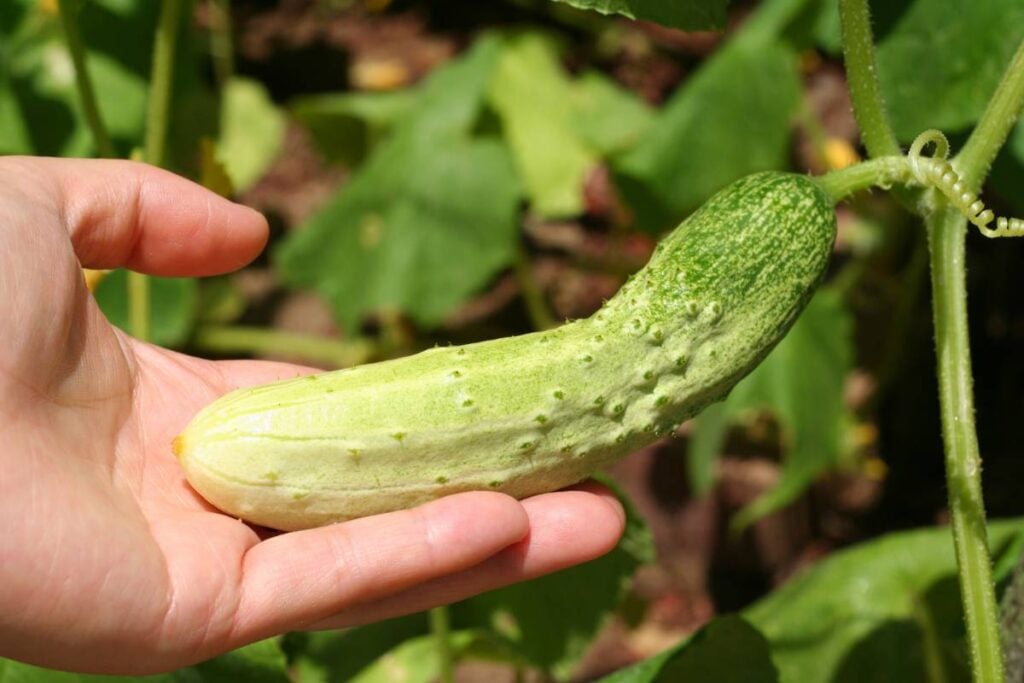
Cucumber Plants: An Overview
The cucumbers belong to the cucurbit family, which also includes melons, cantaloupes, pumpkins, squashes, and zucchinis.
Cucumbers can be classified as both vegetables and fruits.
It depends on how you are consuming them.
Cucumbers are indigenous to India and originated from the Himalayas’ foothills.
These fruits are annual herbaceous plants with climbing or crawling habits.
The plant has large hairy leaves and curling tendrils from the main vines.
The leaves grow alternatively on the vines and have 3-7 pointed lobes.
The vines can climb up a trellis or crawl over the ground.
The root system is shallow, with only one tap root that goes 48 inches deep inside the soil.
The fruits are cylindrical or spherical with tapered ends and 95% moisture.
The plant relies on insects like bees and butterflies for pollination.
They carry the pollen from the male flower to the female flower.
The fruit gets produced by the female flower.
The plant grows best in warm and humid climates with plenty of sunlight and well-drained soil.
Cucumber health benefits
I started vegetable gardening as time pass in the beginning.
But over time, I grew a lot of interest in it.
It has given me a healthier life by tuning in with nature.
Besides this, home-grown fruits are much healthier than market-bought fruits, and I have also reduced the expenses behind these veggies.
Cucumbers have several health benefits. You can even introduce them to your skincare routine.
Cucumbers keep you hydrated, maintain your bone health, and contain anti-inflammatory flavonoids that protect your brain health and improve memory.
Cucumbers also have polyphenols that boost our immune system and reduce cancer risk.
Cucumbers contain several nutrients like fiber, calcium, iron, copper, manganese, magnesium, potassium, phosphorus, vitamins C, B, and K, and many more.
These are great for our health.
Besides gaining these benefits by consuming cucumbers, you can add them to your skincare routine.
You can use cucumbers as a toner and a face pack for extra flow and healthy skin.
Cucumber varieties
There are several cucumber varieties, and you must decide on the variety before you grow them because it makes a lot of impact.
There are several varieties, for example:
- Bristol
- Marketmore
- Gherkins
- Kirby
- Armenian
- Amour
- Northern pickling
Varieties based on user preference
In the usage feature, cucumbers are divided into 3 categories:
- Slicing varieties – You can eat them raw. Slice them to salads, sandwiches, garnish drinks, and other meals.
- Pickling varieties – These are used to make pickles and relish them with meals.
- Seedless or burpless can be both pickling and slicing. Unlike the others, these varieties do not have any seeds.
Some slicing varieties are:
- Sweet success
- Diva
- Marketmore 76
- Tendergreen
- Ashley
The pickling varieties include:
- Gherkins
- Kirby
- Picklebush
- Northern pickling
- Burpee pickles
Varieties based on reproductive features
In reproductive features, cucumbers are again divided into 3 categories:
- Monoecious – The variety contains both male and female flowers.
- Gynoecious – These have only female flowers.
- Parthenocarpic – They do not need pollination for fruits. They grow fruits without pollinating.
Some monoecious varieties are:
- Muncher
- Lemon
- Itachi
- Marketmore 76
- Spacemaster
Gynoecious varieties:
- Mini Much
- Gherkin Hybrid
- Olympian
- Citadel
- Bristol
Parthenocarpic varieties:
- Nokya
- Socrates
- Picolino
- Tasty Jade
- Goliath Hybrid
Varieties based on growth habits
Regarding growth habits, you have two options – vining and bush varieties.
The bush varieties are compact and stop growing after a certain height and length.
For example, Pick-a-Bushel grows only 10-12 inches, and Saladmore Bush Hybrid grows only 8-10 inches.
On the contrary, the vining varieties are uncontrollable.
For instance, Diva grows 5-6 feet long, Mexican sour Gherkins can reach around 3 to 4 feet, and Baby cucumbers grow 6 feet.
You can grow bush varieties in pots, but you need a trellis to let the vines climb up for the vining varieties.
Cucumber planting
When you plant the cucumbers, look at a few things: sowing seeds directly to the ground, starting them indoors and then transplanting them outside, and maintaining proper space and depth.
Direct seed sowing
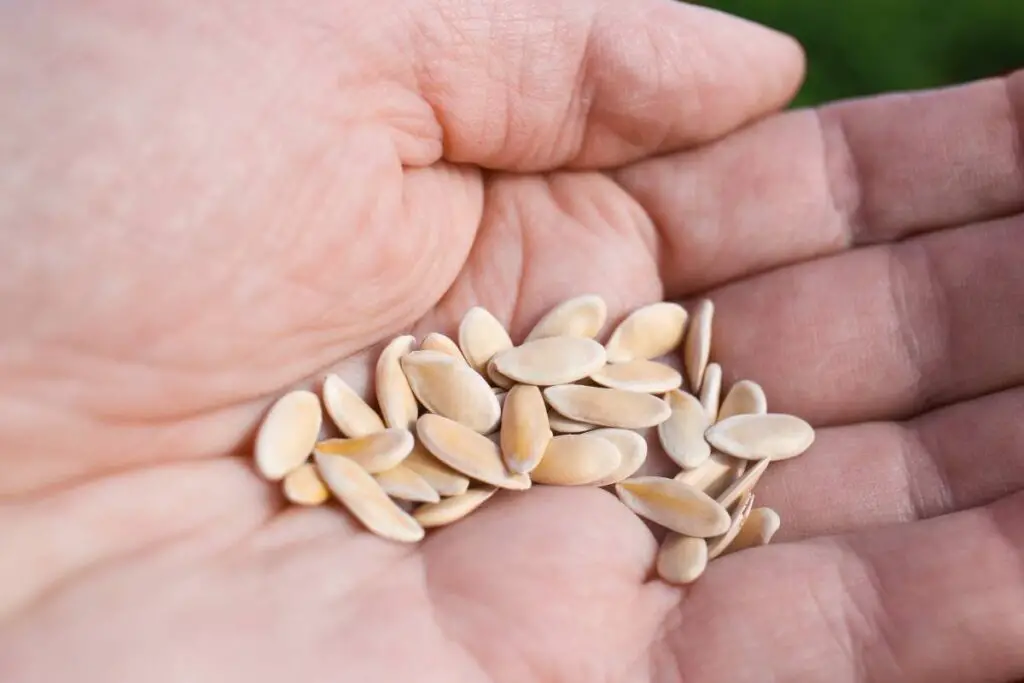
You can directly sow the seeds in the ground or start them indoors.
To directly sow the seeds outdoors in the garden, wait for 2-3 weeks after the last spring frost.
Once the ground thaws and the soil temperature rises to 65°F, you can sow the seeds.
To start the seeds indoors, sow them 4-6 weeks before the last expected frost.
It gives the cucumber plants an extended growing period.
It benefits the cucumbers growing in the colder zones because the growing season is shorter than in warmer zones.
Transplanting cucumbers
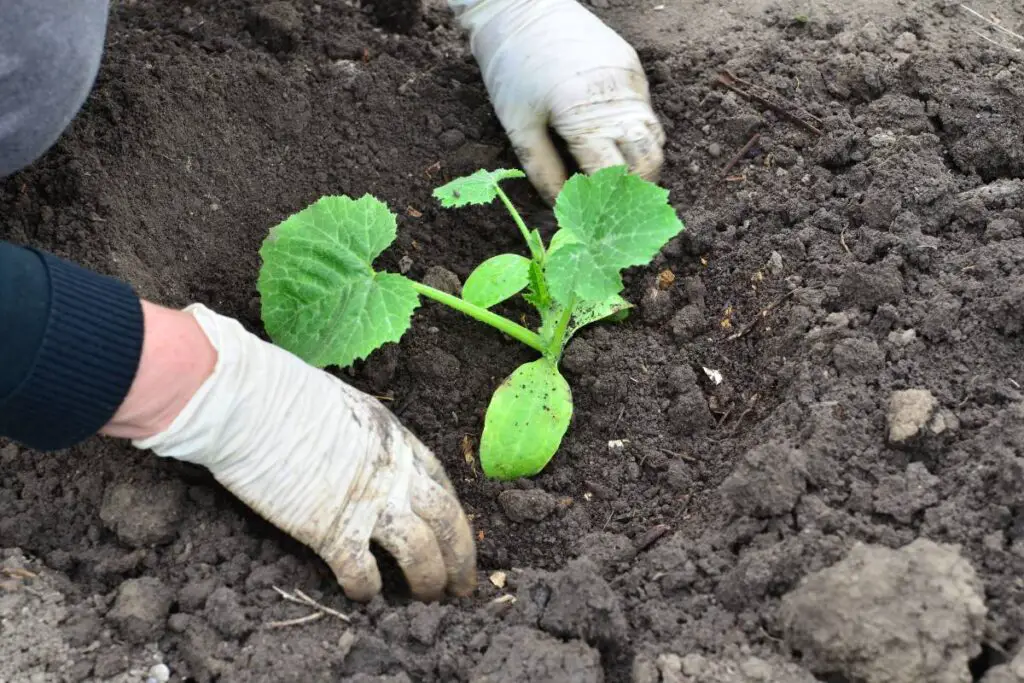
When you start the seeds indoors 4-6 weeks before the last frost, the seedlings get ready for transplantation when the soil temperature rises to 65°F.
The direct seed sowing time also applies to the transplantation timing, i.e., 2-3 weeks after the last frost.
Before you transplant the seedlings outdoors, make sure to harden them off.
Since they grew up in a controlled environment, they may not get acquainted with the sudden outdoor elements and receive a shock.
Expose the plants outside under the direct sun for 2-3 hours on the first day.
Gradually increase the timing to 5 to 6 hours by the 6th or 7th day.
After hardening them off for a week, transplant them outside.
When transplanting them outside, make sure not to disturb the roots.
Remove the seedling from the pot, and without removing the soil lump from around the roots, plant them in the ground with it.
Plant the seedlings immediately and water them well.
Cucumber depth and spacing
While planting, you need to keep in mind the deep and spacing.
The depth is the same for seed sowing and transplanting: ½ to 1 inch deep.
If you have a leggy seedling, go for only 1.5 inches deep, not more than that.
For spacing, keep 3 to 4 feet of distance between each plant.
When you grow seeds, you have to remove the weaker seedlings.
In that case, sow a cluster of three seeds in rows 3-6 feet apart.
Then, again plant them 3-4 feet apart.
In the hills, maintain 1-3 feet spacing.
In the mounds, plant 3-4 seeds per mound.
When seedlings appear, grow 1 seedling per mound.
If you grow the cucumbers in a trellis, sow the seeds at the trellis’ base 4 inches apart and the transplants 6-12 inches apart.
Looking for gardening supplies? We have tested 100's of products before recommending them to you guys. Check out our best pick below:
| Image | Gardening Supplies | Best Price? |
|---|---|---|
 Top
Top Top
Top | Raised Garden Bed Kit | Check On Amazon |
 | XLUX Soil Moisture Meter, Plant Water Monitor, Soil Hygrometer Sensor for Gardening, Farming, Indoor and Outdoor Plants, No Batteries Required | No Results |
 Top
Top Top
Top | 82 Pcs Garden Tools Set and Extra Succulent Tools Set | Check On Amazon |
 | Joeys Garden Expandable Garden Hose with 8 Function Hose Nozzle, Lightweight Anti-Kink Flexible Garden Hoses, Extra Strength Fabric with Double Latex Core, (50 FT, Black) | No Results |
 Top
Top Top
Top | Dual Chamber Compost Tumbler | Check On Amazon |
 Top
Top Top
Top | Sunnyglade Plant Stakes | Check On Amazon |
 Top
Top Top
Top | Organic Cold Pressed Neem Seed Oil | Check On Amazon |
 Top
Top Top
Top | Mighty Mint Gallon :-Insect and Pest Control Peppermint Oil | Check On Amazon |
 Top
Top Top
Top | Scotts DiseaseEx Lawn Fungicide | Check On Amazon |
 Top
Top Top
Top | Jacks Classic 20-20-20 All Purpose Fertilizer | Check On Amazon |
 Top
Top Top
Top | 30,000 Seeds Pollinator Attracting Wildflower Mixture | Check On Amazon |
 Top
Top Top
Top | Survival Vegetable Seeds Garden Kit-Over 16,000 Seeds | Check On Amazon |
Number of plants to plant
The number of plants you need to grow depends on your garden space, consumption level, and user preference.
In every square foot, you can grow around 3-4 plants.
It can vary because the bush varieties may be compact, but the vining varieties take up much space.
So, you may be able to grow 2 plants per square foot.
If you consume cucumbers regularly, 1-2 plants should be enough to feed one person throughout the summer.
Now, you have to estimate this according to your family’s needs.
While sowing the seeds, you may have to sow more than the recommended count because you will eliminate the weaker seedlings.
Sunlight requirements
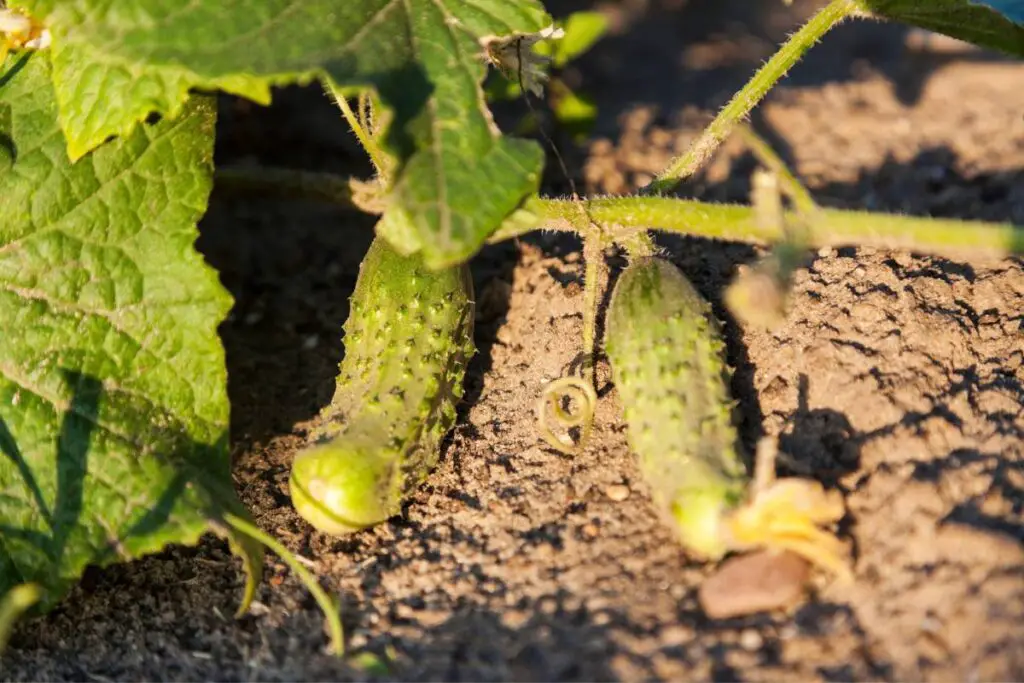
Cucumbers love bright sunlight.
They grow best when they get 8 to 10 hours of sunlight but need at least 6 to 8 hours for optimal growth.
An adequate amount of sunlight encourages good photosynthesis, further improving plant development and fruit production.
Find an ideal location for the cucumbers.
The southern side of the garden can be a good place, but you need to be mindful of the sun’s intensity in summer.
If the weather is too hot and the sunlight is intense, put up a shading cloth to protect the plants from direct sunlight and sunburns.
Water the plant more often to keep them cool and hydrated throughout summer.
Water requirements
Cucumbers love moisture.
Water the plants regularly to keep them hydrated throughout the growing season.
The rule is to water the plant with 1-2 inches of water every week.
But you can increase the watering amount and frequency based on the weather conditions.
If the weather is scorching, water the plant 2-3 times weekly to keep them hydrated.
Make sure the water reaches the roots.
In the pots, water the plant until the excess drains out of the drainage holes.
For the grounded plants, consider drip irrigation.
It will ensure the water reaches the roots and doesn’t get wasted.
Do not overwater the plant; else, it will suffer from root rot.
The best method is to check the soil’s moisture and then water them.
Whenever the top few inches have dried, water the plants thoroughly.
Avoid overhead watering, and always water during the early morning or evening when there is no heat stress.
Soil requirements
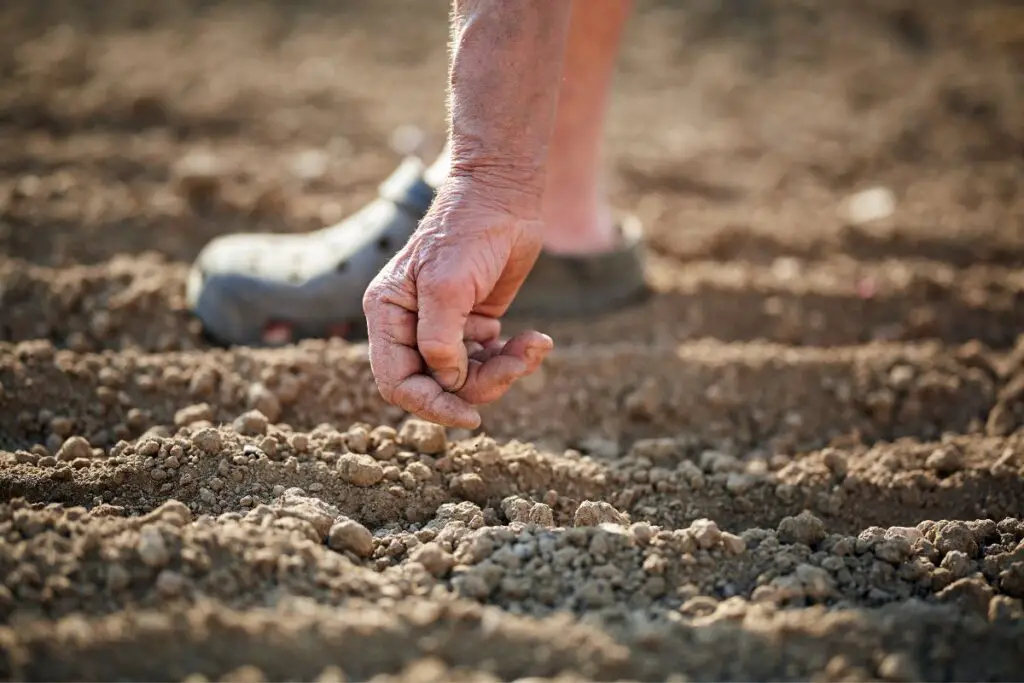
Cucumbers need well-drained, loamy, and nutrient-rich soil for optimal growth.
The plant roots will receive enough moisture with well-drained soil, and the excess will get drained out of the soil through the drainage holes.
Nutrient-rich soil is imperative because cucumbers are heavy feeders.
They need a lot of nutrients to thrive and produce enough flowers and fruits.
The soil also needs to retain enough moisture.
If the soil is poorly retained, all the moisture and nutrients will drain faster than usual.
Adding organic matter to the soil can improve retention, drainage, and nutrition.
Add compost or any organic matter when you prepare the soil before planting.
Soil preparation begins in the fall.
But if the soil degrades again one week before planting, dig the soil, and add organic matter.
Add a layer of mulch to increase retention.
When it breaks down, it can add necessary nutrients to the soil, thus making it more fertile.
The pH level needs to be between 6.0 and 6.5.
Add sulfur or mild sulfuric acid for high pH levels.
As for the low pH levels, use lime and vinegar to adjust the level.
Fertilizer requirements
The cucumbers are heavy feeders.
Though they can survive without fertilization, they will not grow at their optimal rate or produce any fruits and flowers.
There are three stages of fertilization:
- Before planting, when you prepare the soil, add 50% of dry organic matter to the soil.
- After planting, when you add mulch, also add a 2-inch layer of organic matter to the soil.
- When the plant starts growing and reaches a desirable height, fertilize them with a liquid fertilizer every 2 weeks for 8 weeks or with a slow release every month.
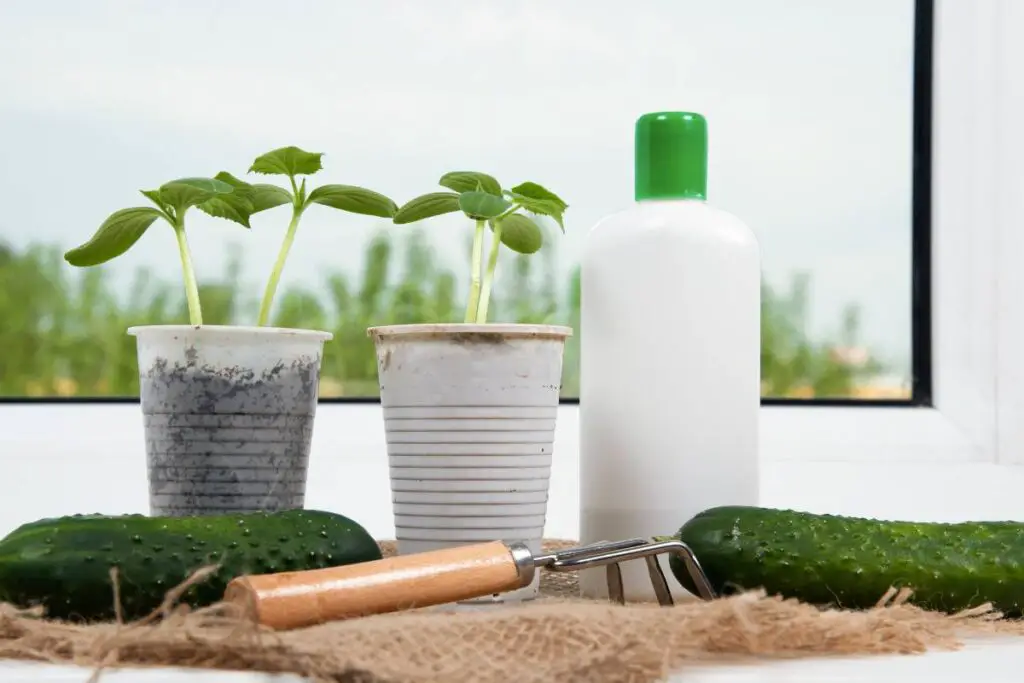
Cucumbers need low nitrogen and high phosphorus and potassium.
You can use a balanced fertilizer with NPK 10-10-10 or 20-20-20.
For high phosphorus and potassium, use fertilizers with NPK 2-3-6 or 3-6-6.
Try bone meal, mustard cake, and sea meal for organic fertilizers.
Temperature and humidity requirements
Cucumbers love to grow in warm temperatures.
The ideal temperature for the cucumbers ranges between 75°F and 85°F.
Cucumbers will suffer from cold damage if they stay below 50 to 55°F temperatures.
Even though it can tolerate up to 32°F, it won’t survive too long.
Whenever the weather is below 50-55°F, take the cucumbers inside the house if they are in pots.
If they are directly growing in the ground, cover them with frost and row covers, and add a layer of mulch to keep the cold from reaching the roots.
If you live in the colder zones where the weather often crosses 50°F, grow cold-tolerant varieties, for example, Socrates, Wisconsin, Russian, Corinto, Amour, Bushy, Siberian (up to 40°F), and Northern Pickling.
During the summers, it is common for the hotter zones to cross 90-95°F. In that case, the plants can suffer from heat stress and dehydration.
You can prevent this by increasing watering and covering the plant with cloth shade during the hottest time of the day.
For the hotter zones, grow heat-tolerant varieties, for example, Olympic, Dasher II, Eureka, Thunder, Beit Alpha, and Spacemaster.
Beit Alpha is the best because it can tolerate up to 100°F.
Cucumbers also need high humidity.
The optimal humidity for the cucumbers is between 60% and 70% during the day and 70% to 90% during the night.
Ensure that the humidity levels remain appropriate to prevent the onset of powdery mildew.
Pruning cucumber plants
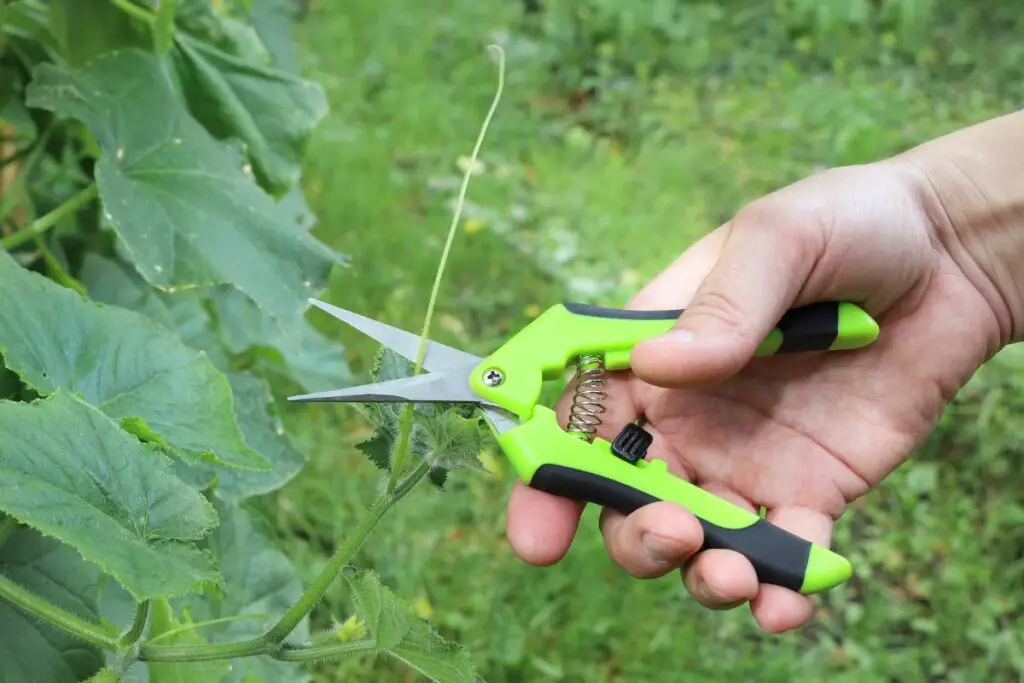
Cucumbers are fast growers, and within a few weeks, they will have lots of vines, lateral shoots, suckers, and leaves.
When vegetation grows too much, the plant constantly uses the energy to grow more of them.
But this will prevent the plant from growing flowers and fruits.
Additionally, too much vegetation reduces air circulation and hinders sunlight penetration to the interior parts of the plant.
Even if there are fruits, the count will be less, and the size will not be up to the mark due to the lack of sunlight.
Pruning will let the plant grow more fruits and flowers and increase air circulation and sunlight penetration.
Prune the suckers, the dead and damaged leaves, lateral shoots, and the lower leaves.
Also, prune some outer leaves if the growth is too much and some vines when the plant grows more than the desired length.
Always begin pruning the plant when it crosses 1-2 feet in height.
Pruning before that can stress the plant.
Cucumber pollination
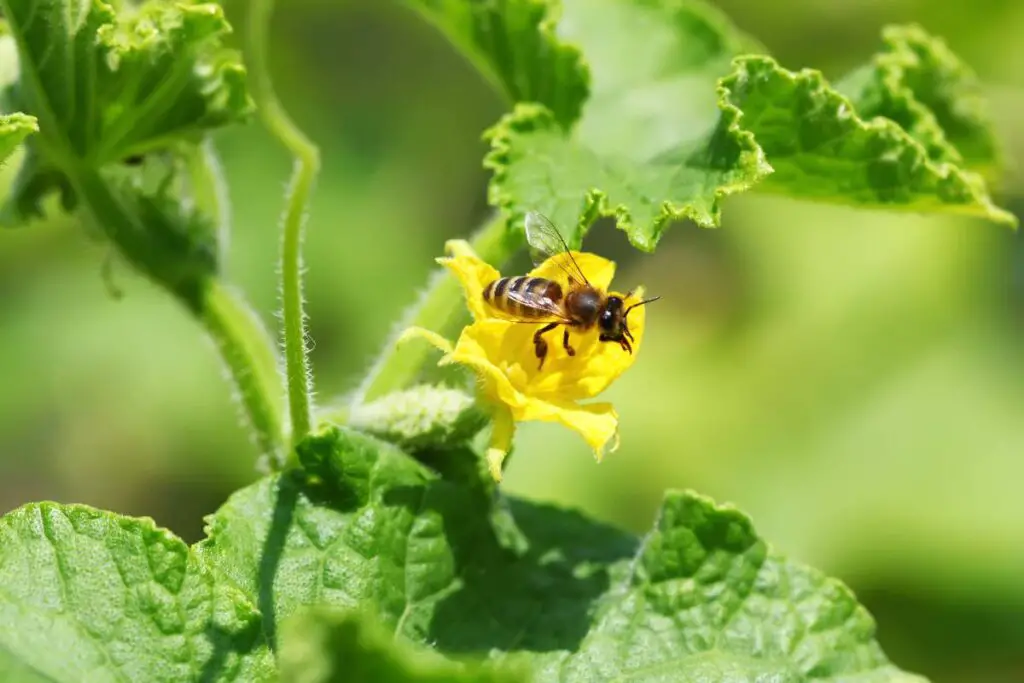
Cucumbers rely on pollination. They self-pollinate with the help of natural means like air, wind, and pollinators like bees and butterflies.
When you grow monoecious varieties, the plants efficiently pollinate as they have both male and female flowers.
But for the gynoecious varieties, pollination is challenging as they grow only female flowers.
Grow these two varieties close to each other for cross-pollination.
Use a paintbrush or cotton swab to transfer pollen from male to female flowers if natural pollination is impossible.
Or, break the male flower and rub it against the female flowers.
The male flowers grow in clusters and appear early.
The female flowers grow individually over a singular stem after the 1st or 2nd flush of male flowers.
Cucumber trellising
Trellising the cucumbers has a lot of benefits.
In fact, trellising would be best for them instead of growing them in the ground.
First, you can do vertical gardening with a trellis, so you have much space to grow in your garden.
Since these plants can climb, a trellis can support the vines and encourage the plant to grow upwards.
When the plant grows upwards, it grows towards the sun and, therefore, receives more light than those in the ground.
In a trellis, caring and harvesting becomes easier.
You do not need to bend to provide the resources or check the cucumbers’ condition; you can easily spot and harvest them.
Since the plant will be above the ground, there will be lesser chances of pests, soil-borne diseases, and dirt.
You receive healthy, juicy, and clean fruits.
Harvesting cucumbers
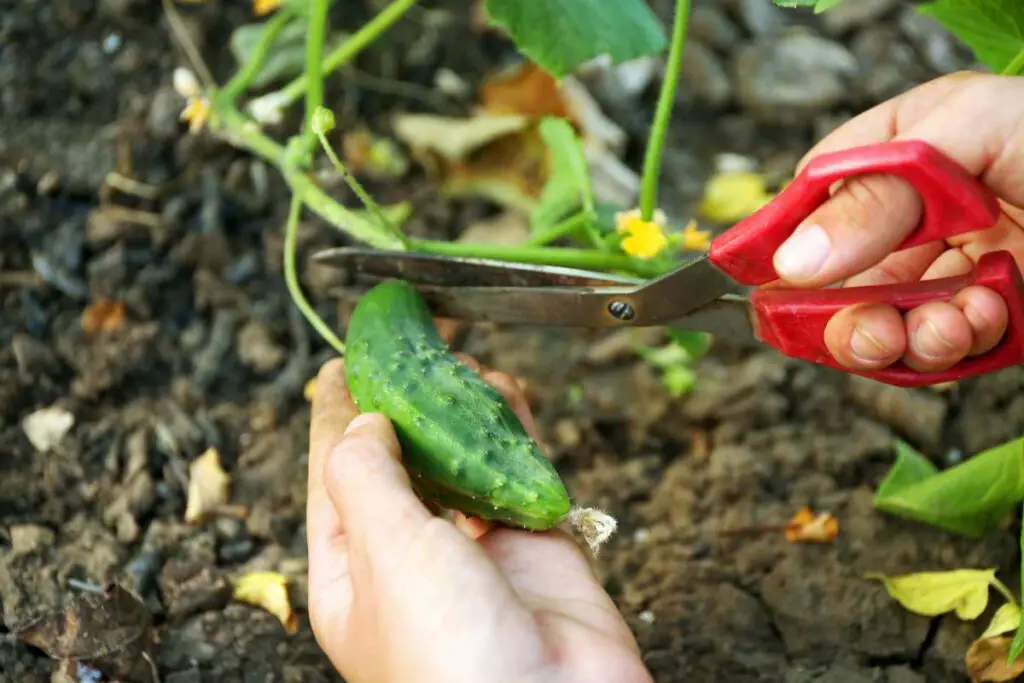
The right time to harvest the cucumbers is after 50 to 70 days of planting.
By this time, the cukes will mature and have a proper texture, intense flavor, and rich green color with a light green hue.
The mature size for the slicing varieties is 6-9 inches, and the pickling varieties are 2-4 inches.
You can harvest them slightly earlier than the actual harvest time.
These cucumbers will be crunchy and taste sweet, less intense than the fully-mature ones.
If you are okay with crunchy cucumbers, go on with early harvest.
But do not harvest them late.
The plants have a chemical called cucurbitacin, which gives the leaves and stems a bitter taste that prevents animals from chewing.
If the fruits stay in the plant for too long, the chemical passes to the fruits, thus making them bitter. So, please pick them up on time.
Harvest the cucumbers during the on-peak or off-peak season every other day during the early morning when the stems are cool and not stressed by the sun’s heat.
Leaving 1 to 1.5 inches of the stem, cut the cucumbers and collect them in a bucket.
Do not twist or tear them, and be gentle to avoid bruises.
Storing cucumbers
When you receive too many cucumbers after harvest, you will want to store them for future use.
There are several methods to store the cucumbers.
For the short term, store them at room temperature in a bucket or bowl of cold water for a few days.
Wash the cucumbers, dry them, wrap them, and store them in a refrigerator for a week.
For the long term, slice them and freeze them as ice cubes.
Other methods of preservation are pickling, fermentation, canning, dehydration, and making powder from dehydrated cucumbers.
Some traditional storage methods involve preserving the cukes in the sand, reservoir, wells, and vinegar.
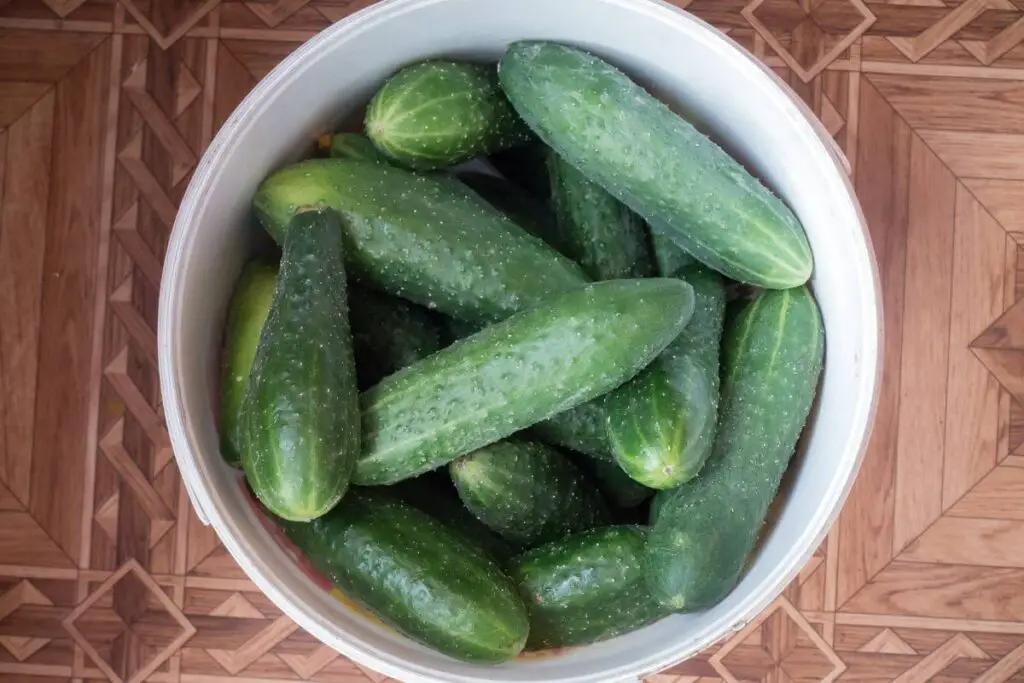
Common Cucumber problems
Despite taking care of the cucumber plants, they face several problems.
The reason might be cultural issues, or the plant got infected by bugs and diseases.
Below are some common issues you will face, the reason behind them, and the ways to troubleshoot them:
Stunted growth
Poor planting, lack of nutrition, weather conditions, and infestations are common reasons.
Planting cucumbers close to each other leads to a lack of space, air circulation, and resource competition.
These problems altogether hamper the plant’s health, leading to stunted growth.
So, maintain at least a 3 to 4 feet distance between them.
Please provide enough fertilizers and grow them in well-drained nutrient-rich soil.
Give them enough moisture and ensure they get at least 6 to 8 hours of sunlight.
Leaves turning yellow
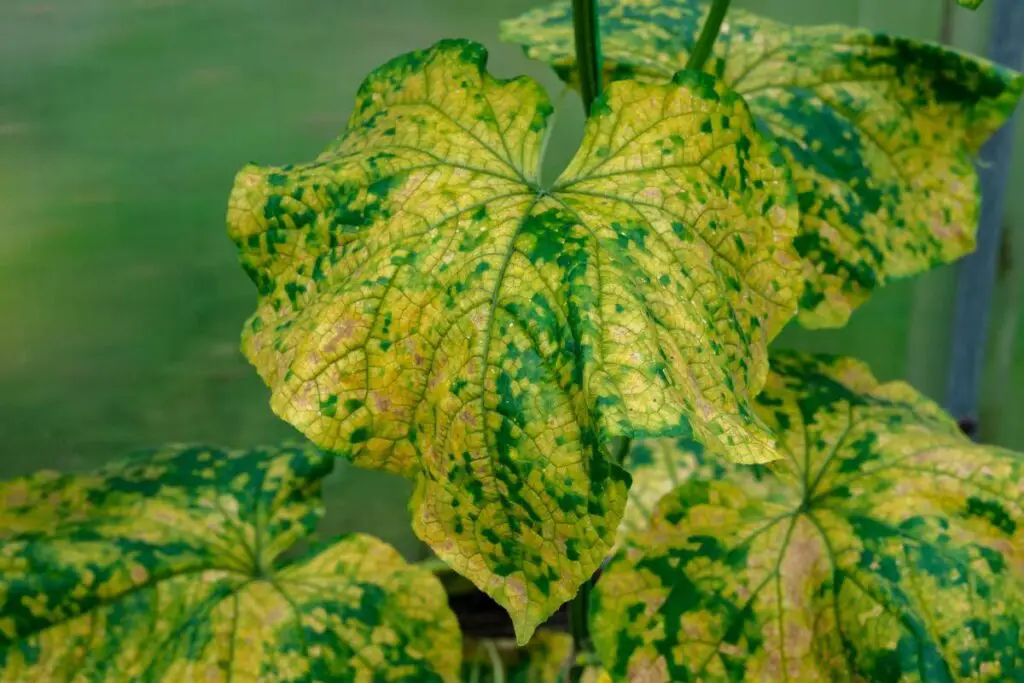
Lack of nutrition can cause yellowing.
Sometimes, the young leaves turn yellow; sometimes, the leaves get yellow, and only the veins remain green.
Use a balanced fertilizer or add organic matter to the soil.
Both water and sunlight help in producing chlorophyll that encourages deep green leaves.
Without them, the leaves will produce less chlorophyll, lose color, and turn yellow.
Let cucumbers have at least 6 to 8 hours of sunlight.
Keep the soil evenly moist, neither too wet nor too dry.
Diseases like mosaic virus, fusarium wilt, and powdery mildew can also cause yellowing.
Spray some neem oil for powdery mildew on the affected area every week until the problem gets resolved.
In mosaic virus, the yellow leaves have a mosaic pattern.
Remove the entire plant and the weeds around to eliminate the disease.
The virus can stay in the soil for too long and affect the plants you grow in the next year.
Consider crop rotation and solarize the planting location before planting.
The same goes for the fusarium wilt.
Remove the plant to prevent the spreading of the pathogens.
Aphids and white flies suck the plant sap from the cucumber leaves, turning them yellow and curly over time.
Dislodge the pests with water force, and spray neem or horticultural oil.
If the problem persists, use insecticides and pesticides to eliminate the pests.
Leaves are dying
The leaves may sometimes wither away, yet the vines still bear fruits and flowers.
Cucumber plants are rapid growers and need plenty of moisture.
The leaves can become dry and curly and die if the plant is dehydrated for too long.
Water the plant whenever the top 1-2 inches have dried. Make sure to irrigate the soil to the root level.
Diseases like bacterial wilt and mildew also affect the leaves and kill them over time.
Pests such as aphids and whiteflies feed on the sap.
They can kill the plant if not addressed quickly. Use horticultural oils and insecticidal soaps.
Maintain proper sanitation, keep the surroundings neat and clean, and consider crop rotation.
Cucumber leaves wilting and browning
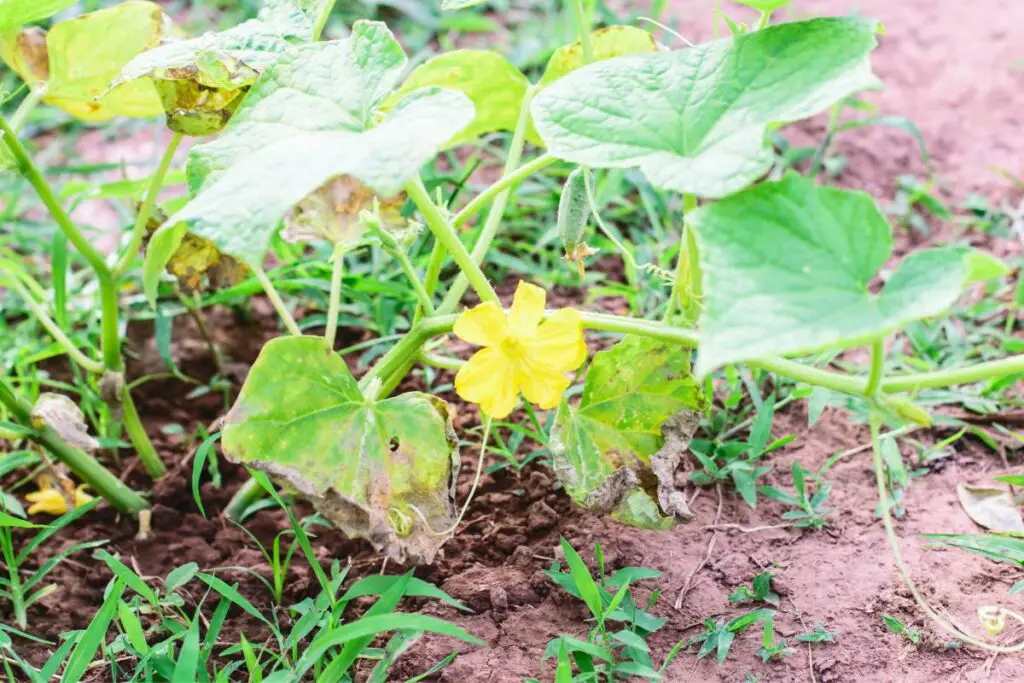
One common reason is bacterial wilt.
When the disease occurs, you see sudden wilt and brown streaks in the leaves overnight, but they are okay again in the morning.
Unfortunately, the disease is untreatable.
You must destroy the plant to prevent the pathogens from spreading.
Pests like squash bugs make tunnels through the vines, wilting the leaves.
Other than that, the sap-sucking pests suck out all the moisture and wilt the leaves over time.
Use horticultural oils and pesticides to control and kill them from spreading. Introduce beneficial insects to let them feed on these bugs.
Nematodes can also wilt the leaves because they feed on the roots and stop the plant from absorbing moisture and nutrients.
Consider crop rotation and solarize the soil before planting or sowing for 4 to 6 weeks in the summer.
Sometimes, it is just the heat stress.
When the temperature crosses 90-95°F, water them more often and put up a shade during the hottest time to protect them from the intense sunlight.
Cucumber flower dropping
When the male flowers drop off the plant, it indicates they have spent their pollen and are useless.
Some early flowers fall off the plant when the female flowers have still not appeared.
The female flowers get produced after the second flush of the male flowers.
However, if the female flowers drop off, too, the plant suffers from extreme temperatures.
Both high and low temperatures are harmful to cucumbers.
So, ensure that the plants are protected during these times.
When the temperature exceeds 90-95°F, increase watering to keep them cool and protect them from sunlight by putting shade.
In the winter, cover them with frost or row covers when the temperature goes beyond 50-55°F. Or, take them indoors.
Another reason is the lack of pollination.
The flowers start falling off when they don’t pollinate for too long.
Pesticides like carbaryl prevent pollinators from roaming about your plant. In that case, hand-pollinate them.
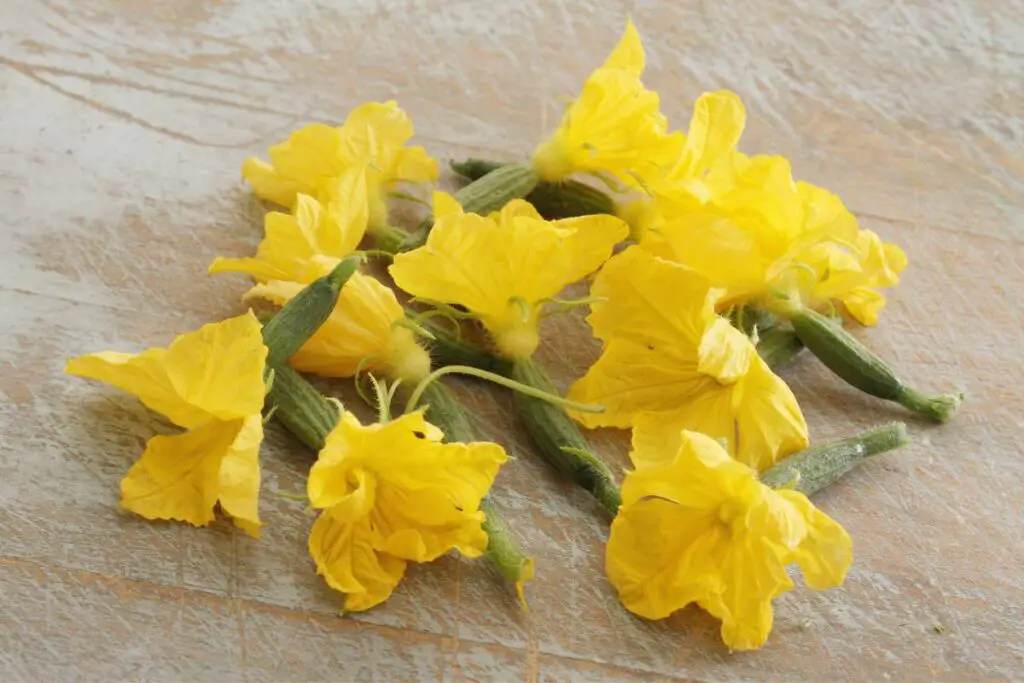
Cucumbers have no fruits
A lack of pollination leaves the cucumbers with only flowers but no fruits.
Lack of male or female flowers and pollinators reduces the chances of pollination.
Monoecious plants have male and female flowers, but gynoecious plants have only female ones.
Sometimes, the monoecious varieties will grow female flowers too late or won’t grow due to heat stress.
So, growing monoecious varieties with gynoecious plants will benefit both plants and encourage cross-pollination.
If there is a lack of pollinators, wind, and air, hand-pollinate them to encourage pollination.
Bitter fruits
The only reason behind bitter fruits is late harvest.
The leaves and stems of the cucumber plants contain cucurbitacin B and C.
These make the taste of the leaves and stems bitter, therefore, keeping the animals at bay.
When the fruits stay in the plant for too long, these chemicals start moving into the fruits when they stay in the plant for too long.
That is why when you harvest them late, you have a bitter taste in them.
The right time to harvest the cukes is 50 to 70 days after planting.
Common cucumbers pests
Several pests can attack the cucumber plants:
Aphids, spider mites, and whiteflies
These are the most common pests found in cucumber plants.
They suck out the sap of the plants and leave the plant dehydrated.
Over time, the leaves lose their color and vigor, turn yellow and curly, and end up dying.
Aphids are challenging to spot with the naked eye and come in various colors, like pink, brown, red, and black.
The spider mites are either black or red, resembling tiny spiders.
The leaves will have web-like structures along with curliness and discoloration.
The whiteflies are white and resemble tiny fruit flies.
These pests get attracted by prolonged wetness around the soil.
They leave the leaves sticky because of their honeydew residue.
If the plant is strong and healthy, it can fight the infestation.
But if it is weak, the plant can die.
For solutions, first, shower the plant with enough water force to dislodge the pests.
Spray some neem oil or horticultural oil on the affected leaves.
When you treat the plant, do it in the evening when the heat stress is absent.
If the infestation is too much, kill the bugs by adding beneficial insects to feed on all the bugs or using insecticidal soaps and pesticides.
Cabbage loopers
These bugs chew the leaves and create holes in them. So, the damage is enormous if they stay for too long.
You can recognize the damage by the small holes in them. Over time, they will kill all the leaves and the vines.
Add beneficial pests, like parasitic wasps, to feed on the loopers. Remove the eggs and worms from the plant and cut off the damaged parts.
Cucumber beetles
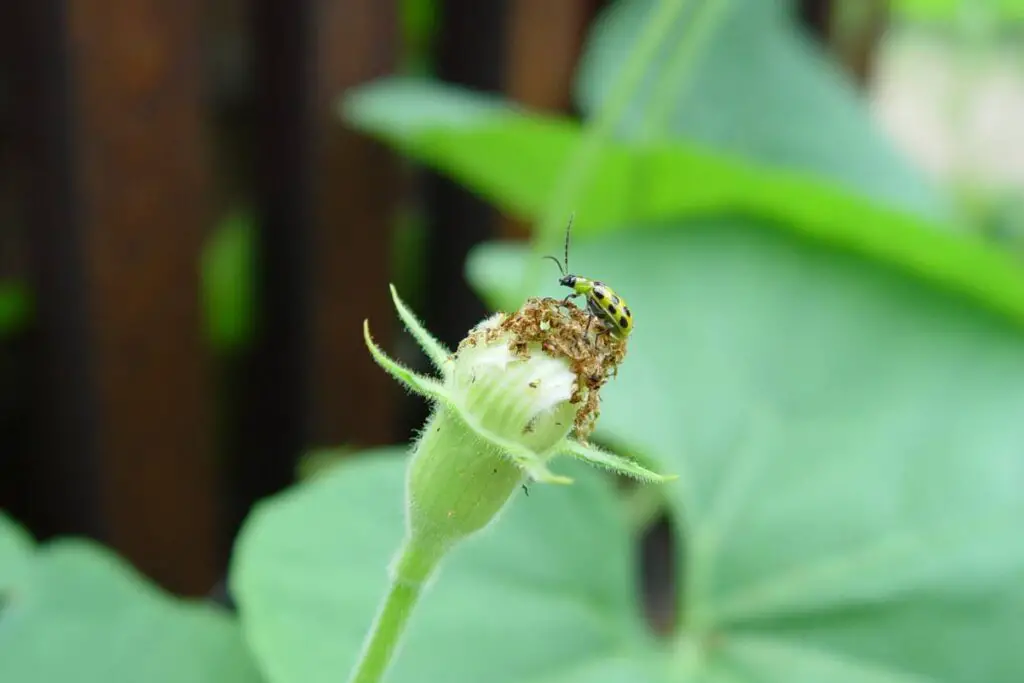
Beetles are common in all the cucurbit families.
They eat up both leaves and flowers and, over time, kill the whole plant.
Their larvae eat up the plant roots and damage their growth and development.
To prevent the disease, grow beetle-resistant varieties.
Cover the plants with a floating row cover after the seeds germinate and open when the plant is about to flower for pollination.
Trap the bugs with sticky trap cards.
Cutworms
The larvae of these worms hide during the day and get active at night.
That is why detecting the damage is difficult.
The bugs feed on the stems of the seedlings and young plants.
You will find irregular holes in the fruits.
If you examine the soil closely, you will find them curled in the soil debris.
To prevent these bugs, remove all the plant debris before you plant the cucumbers.
Spread some diatomaceous earth around the plant base.
If the infestation is too much, use pesticides in the affected areas.
Flea beetles
These bugs make small holes in the cucumber leaves and damage the plant.
If the infestation persists, the plant will stop growing and die after some time.
To prevent bugs from emerging, use floating covers or apply a layer of mulch around the plant.
Plant trap crops as companions near the cucumbers and use diatomaceous earth or neem oil to eliminate them.
Common cucumber diseases
Some common diseases found in the cucumber are as follows:
Powdery mildew
The reason is high humidity and lack of air circulation.
The leaves will have white marks resembling scattered powder.
Over time the leaves become yellow.
Controlling this disease is easier than any other problem.
Spray neem oil or horticultural oils on the affected leaves.
Grow mildew-resistant varieties like Thunder, Indy, and Alibi.
Bacterial wilt
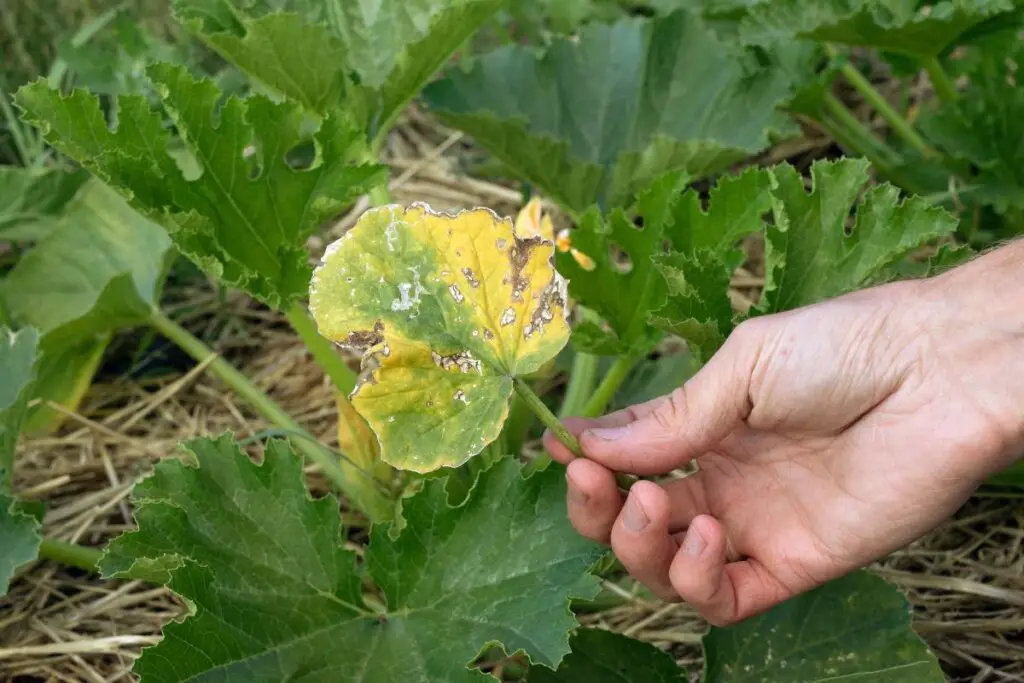
The disease leads to sudden wilting overnight, but the leaves become normal during the day.
The bacteria affects the vascular vessels, therefore, making them wilt overnight.
Unfortunately, there is no treatment. Isolate the plant and destroy it.
If only a few plants get affected, immediately quarantine the plant, remove the damaged leaves, and add pesticides to control the disease from spreading.
Grow disease-resistant varieties like Country Fair, Little Leaf, and Cross Country.
Mosaic virus
The leaves will be yellowing with a mosaic pattern.
Slowly, it will affect the flowers and stem and hamper the plant’s growth.
The leaf size will reduce, become curly, and fall off after some time.
The disease gets spread mainly through aphid infestation.
Provide pesticides and mineral oils to prevent bugs and grow disease-resistant plants.
Alternaria leaf blight
The disease primarily affects the older leaves.
Common signs are tiny brown spots that progress to irregular shapes with a yellow halo.
After some time, the leaves will turn brown and die.
Apply fungicides to control the disease, provided it has not affected the plant too much.
Spray homemade fungicides made with soapy water, baking soda, and vinegar.
Remove the affected leaves to avoid the pathogens from spreading.
Grow disease-resistant varieties like Citadel and Little Leaf.
Anthracnose
You will find round, yellow marks on the leaves.
The spots will be small initially, but over time, it turns larger, indicating the disease has progressed.
The leaves wilt, die, and fall off the plant as time flies.
Spray some fungicides as per the instructions given on the labels.
I have used Chlorothalonil and Benomyl for some of my diseased plants.
Final thoughts
Cucumbers are popular and easy-to-grow plants. Any beginner can start vegetable gardening with cucumbers. Growing them will be easy and exciting once you know the proper care tips. Provide adequate sunlight, water, and fertilizers, and plant them during warm temperatures when the soil is 65-70°F.
Grow them in well-drained and nutrient-rich soil, prune the overgrown areas, and use a trellis to support the long vines. Protect them from extreme temperatures. You can either sow the seeds directly in the soil or start them indoors. If you do the latter, transplant the seedlings outside after hardening them.
Maintain at least 3 to 4 feet distance between each plant. Harvest the cucumbers immediately and store the excess cukes for future use. Check for pests and diseases and act quickly to address them. Opt for disease-resistant plant varieties to combat infestations more effectively.
Reference: Cucumber Wikipedia
